Although the career of this German artist was cut short during World War I, he left behind an impressive oeuvre of Expressionist paintings.
Franz Marc (1880-1916) was born in the city of Munich as the son of a professional landscape painter. He studied at the Academy of Fine Arts in his home city.
He traveled frequently and discovered the oeuvre of Vincent van Gogh while living in Paris in the early 20th century.
His career took a drastic turn when he met his German colleague, August Macke (1887-1914), who was just like Marc a leading figure of German Expressionism.
Both men developed a revolutionary colorful style in the short period they produced artworks in the years before the outbreak of World War I.
Marc became the co-founder of Der Blaue Reiter together with Russian artist Wassily Kandinsky (1866-1944) in 1911. This journal featured several of Marc’s colorful paintings that were inspired by Cubism and Futurism.
Referred to as “degenerate art” by the Nazis, today, his paintings sell for astounding amounts of money, including a whopping £42.6 million sale at Christie’s in 2022.
In this article, you’ll discover some of the most famous paintings by Franz Marc.
1. Blue Horse I
- Date created: 1911
- Dimensions: 112 × 84.5 centimeters (44 in × 33.3 in)
- Location: Lenbachhaus, Munich, Germany
Blue Horse I is the title of one of the most iconic paintings by Franz Marc. It was exhibited at the annual event of the Blaue Reiter and has been closely linked to the formation of this artistic group and journal.

The blue horse was a recurring subject for Marc as he identified was the spiritual compass of the group. This was too complicated for contemporary viewers to understand and his paintings were, therefore, often ridiculed.

2. The Foxes
- Date created: 1913
- Dimensions: 88 × 66 centimeters (35 × 26 inches)
- Location: Private Collection
The Foxes is a painting that was highly influenced by cubist paintings, including the world of Robert Delauney and other Cubist artists. The painting breaks down the animals in fragments and recomposes them in harmonious colors.
The painting was once owned by a Jewish investment banker named Kurt Grawi who managed to flee from the Sachsenhausen concentration camp. It was later donated to the Kunstpalast in Düsseldorf until it was sold for £42.6 million at Christie’s in 2022 by Grawi’s heirs.
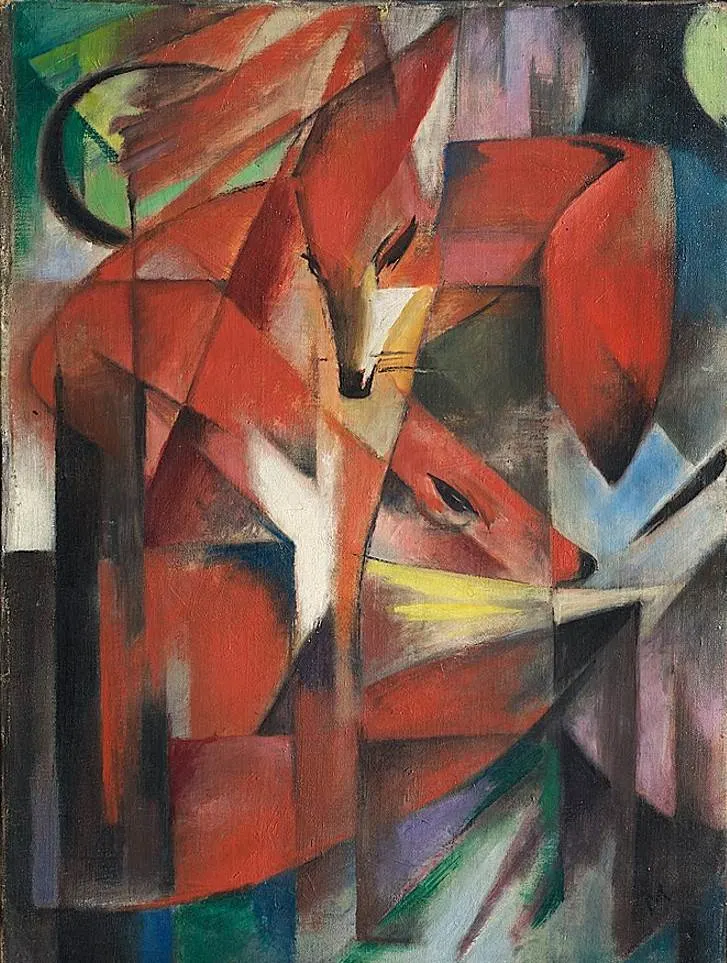
3. Yellow Cow
- Date created: 1911
- Dimensions: 140,5 × 189,2 centimeters (55.3 × 74.5 inches)
- Location: Guggenheim Museum, New York City, United States
Yellow Cow is the title of another famous painting by Franz Marc. It depicts another common animal, a cow, in bright yellow, as it appears to be jumping in a colorful landscape.
While blue was the color of spirituality for Marc, he identified yellow with feminity and sensuality. The landscape features a dominating red which was the color for the Earth in Marc’s color symbolism.

4. The Large Blue Horses
- Date created: 1911
- Dimensions: 105.7 x 181.1 centimeters (41.6 x 71.3 inches)
- Location: Walker Art Center, Minneapolis, United States
The Large Blue Horses is sometimes referred to as simply “Blue Horses” and depicts 3 amazingly blue horses. It was another trademark work of art for the Blaue Reiter group in the years before World War I.
Although it’s less famous than Blue Horse I, it’s considered to be one of the most important large-scale works by Marc which he produced in 1911 due to the bright color scheme of both the horses and other elements.
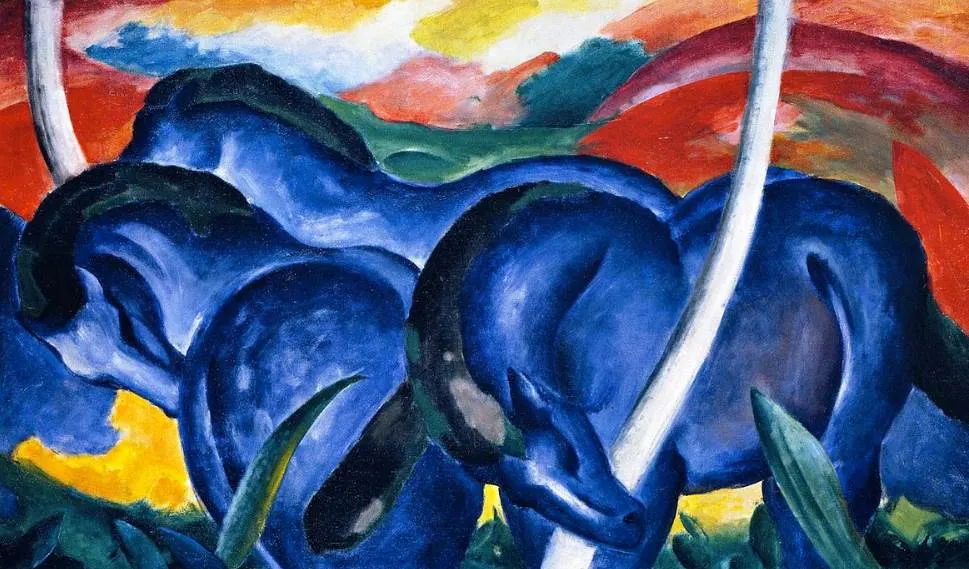
5. Fate of the Animals
- Date created: 1913
- Dimensions: 196 x 266 centimeters (77.1 x 104.7 inches)
- Location: Kunstmuseum, Basel, Switzerland
The Fate of the Animals is one of the most intriguing works of art by Franz Marc for several reasons. It’s one of his largest paintings and features animals that appear to be slaughtered violently.
This is in contrast with the animals who appear to be grazing or having a good time in enjoyable colorful landscapes. Equally remarkable is the fact that the painting was damaged and restored by Marc’s friend Paul Klee (1879-1940). For an unknown rationale, he used a brownish tint to recreate the damaged part.
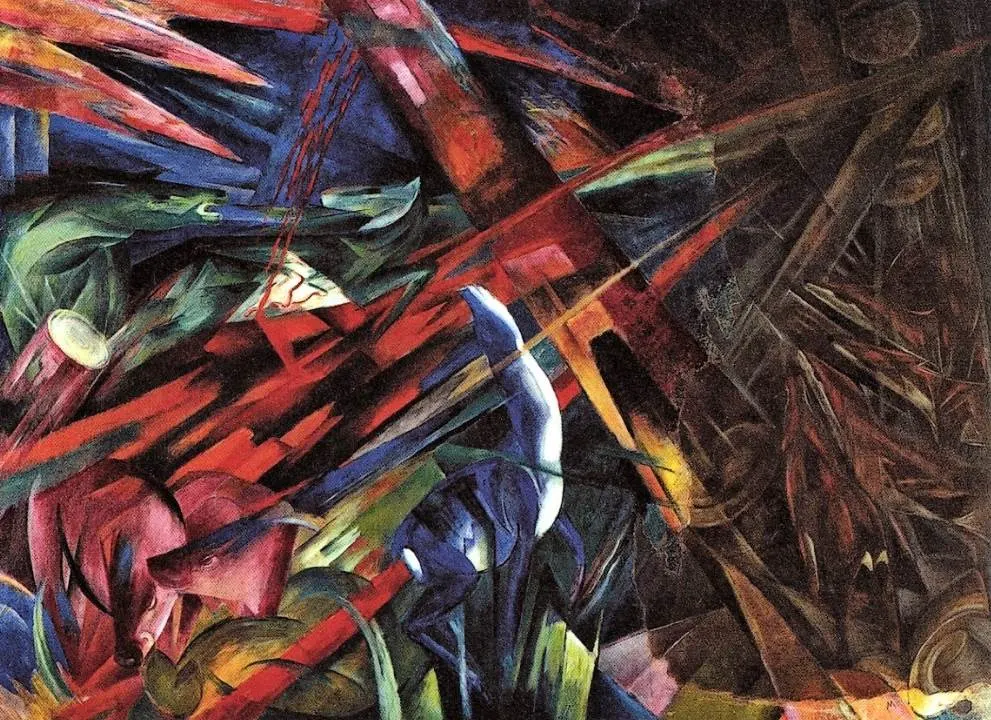
6. Little Blue Horse
- Date created: 1912
- Dimensions: 57.5 × 73 centimeters (22.6 × 29 inches)
- Location: Saarland Museum, Saarbrücken, Germany
Little Blue Horse is a painting by Marc that can be described as the complete opposite of the Fate of the Animals. It depicts a cute blue horse in the typical bright colorful setting that makes Marc’s paintings so distinctive.
The reason why it depicts a young horse is that it’s a painting that was completed as a gift for Walterchen, the son of the artist’s friend August Macke. We know this because Marc added a small description in the top right corner.

7. Fox
- Date created: 1911
- Dimensions: 50 × 63,5 centimeters (20 × 25 inches)
- Location: Von der Heydt Museum, Wuppertal, Germany
Fox is the title of a painting that is also sometimes referred to as “Blue and Black Fox” or “Blue Fox.” It was completed in August Macke’s studio in Bonn shortly after Marc returned from a trip to England.
He finished this work in July 1911 which was several months before the first exhibition of Der Blaue Reiter took place on December 18 of that year. It was one of the first paintings in which Marc experimented with the use of pure bright colors.
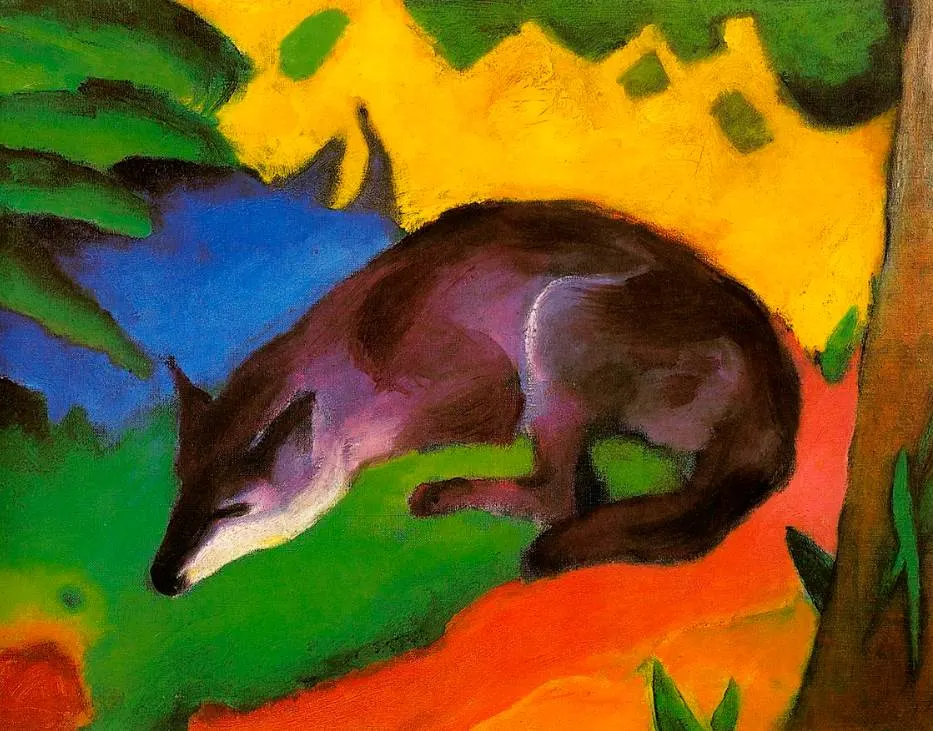
8. The Tower of Blue Horses
- Date created: 1913
- Dimensions: 200 x 130 centimeters (78.7 x 51.1 inches)
- Location: Unknown
The Tower of Blue Horses is a large painting that depicts one of Marc’s favorite subjects, blue horses. Nothing is known about the artist’s motivation to paint animals in the first place which adds intrigue to his oeuvre.
The German artist already started producing sketches for this work in 1912 of which one in postcard format survives today. He completed this huge oil painting in the Summer of 1913. The painting was moved to Berlin but need up being banned by the Nazis. Nobody knows where the painting is today as it disappeared following the conclusion of World War II in 1945.
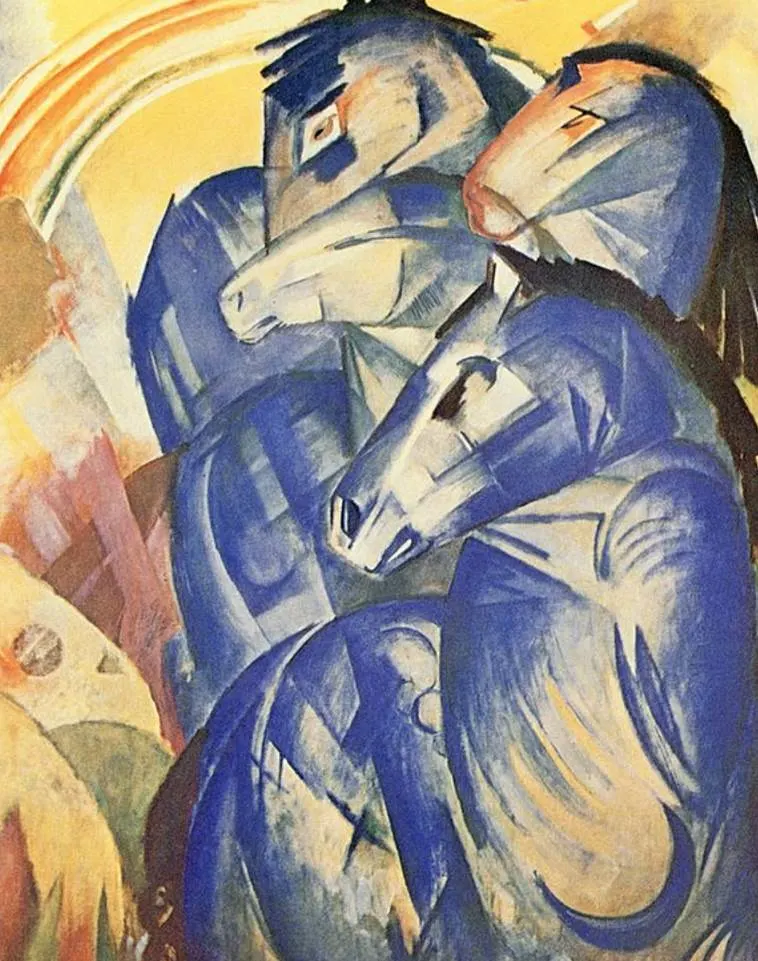
9. Animals in a Landscape
- Date created: 1914
- Dimensions: 110.2 × 99.7 centimeters (43.37 × 39.25 inches)
- Location: Detroit Institute of Arts, Detroit, United States
Animals in a Landscape is another painting by Marc that shows that he was heavily influenced by the Cubist art movement during the final years of his life.
Animals and colors dominate his paintings and very few works in his oeuvre exemplify this notion better than this remarkable work of art. This colorful composition hides several animals as Marc aimed to depict nature as abstractly as possible.

10. Fighting Forms
- Date created: 1914
- Dimensions: 91 x 131 centimeters (35.82 x 51.57 inches)
- Location: Bavarian State Painting Collections, Munich, Germany
Fighting Forms is the title of the final painting that Franz Marc completed before he enlisted to fight in World War I. he did so as soon as the war broke out and completed this work as a representation of the conflict.
The turmoil is depicted as a huge red parrot being dragged into a black hole. Franz Marc could have been saved because there was an order to spare artists from combat to protect German art. The message didn’t reach him and he was killed in the Battle of Verdun in 1916.

